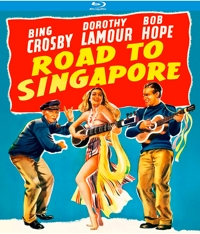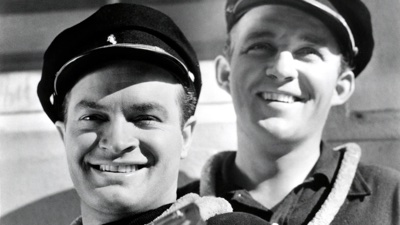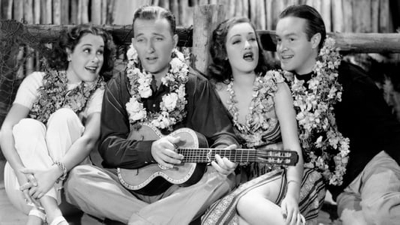 Grade: B
Grade: B
Entire family: Yes, but….
1940, 85 min., Black & White
Comedy
Kino Lorber
Not rated (would be PG for drinking, smoking, and innuendo)
Aspect ratio: 1.37:1
Featured audio: DTS Mono
Bonus features: B-
Trailer
Amazon link
Today’s parents may have grown up watching some of the old Bob Hope, Bing Crosby, and Dorothy Lamour “Road” pictures on television. If so, there’s a good chance they might want to share them with their children.
A showcase for Crosby’s crooning, Lamour’s singing and dancing, and Hope’s second-banana wisecracking, the Road pictures were pure escapism for an America that was weighed down by WWII. Hope and Crosby, two vaudevillians who rose to become popular stars of their own radio shows, had made the leap to film, and the genius who paired them deserves a medal. The first of the Road pictures, The Road to Singapore, became the highest grossing film of 1940. Though it’s not the best—that honor goes to Road to Morocco (1942) and Road to Utopia (1945)—it lays the foundation  for the films to come, though it was originally only intended as a one-and-done film. But the public wanted more, and Road to Zanzibar followed in 1941, and Road to Rio (1947), Road to Bali (1952, the only color release), and the Cold War entry The Road to Hong Kong (1962). All of the films were made during a time when Hollywood (and the rest of the world, really) was not terribly educated about or sensitive to issues of race and gender. So you’re going to have to overlook some period-typical dialogue and characterizations, as well as “natives” that seem a blend of big Hollywood musical dancers and a bag full of different cultures. Thankfully, Hope and Crosby make that easy to do.
for the films to come, though it was originally only intended as a one-and-done film. But the public wanted more, and Road to Zanzibar followed in 1941, and Road to Rio (1947), Road to Bali (1952, the only color release), and the Cold War entry The Road to Hong Kong (1962). All of the films were made during a time when Hollywood (and the rest of the world, really) was not terribly educated about or sensitive to issues of race and gender. So you’re going to have to overlook some period-typical dialogue and characterizations, as well as “natives” that seem a blend of big Hollywood musical dancers and a bag full of different cultures. Thankfully, Hope and Crosby make that easy to do.
In all of the Road pictures, they play a couple of ne’er-do-wells who are either petty con men and womanizers seeking to stay one step ahead of the law or world-traveling vaudeville-style entertainers . . . and womanizers seeking to stay one step ahead of the law. That might not sound like family entertainment, but the pictures truly are escapist fare with an emphasis on the one-liners, ridiculous plots, and the inevitable romantic tussle over Lamour (with Crosby always getting “the girl”).
For families with younger children, a good place to start might be the only color release, Road to Bali, which is slightly faster paced than The Road to Singapore and features a squid-wrestling sequence. Despite some racist elements, The Road to Zanzibar, with its safari-centered plot, is another good option if the kids are smaller. The two best are best because of the one-liners, so they’re recommended as good starting points for families with older children.
So where does that leave The Road to Singapore? Probably as a film to watch once the family gets hooked and wants to see more—although Singapore does have a lot going for it. This one set the formula that all the rest would follow, with Crosby always trying to take advantage of his friend, often by talking him into doing dangerous things so the pair can get money to eat. In Singapore, Crosby plays the rich heir to a shipping giant, but rather than take a boardroom seat he prefers hopping from one family ship (and adventure) to another, with romances at every port. Ace is also a playboy though less well off financially. The two of them work as hands on a ship to pay their way, and clichés of the hen-pecked husband keep them swearing off getting serious with any one female. Josh (Crosby) has a fiancée, who’s patient enough to wait for him to sow his wild oats. But their getting together seems unlikely after Josh and buddy Ace show up with a big marlin underdressed to the hilt for a society party aboard a ship in the harbor. And here is where Crosby and Hope perform the film’s most memorable number: “Captain Custard,” where they mug and cavort with the women in the cabin and eventually start a fistfight with some of the men. How? By what would become a Road picture staple: playing patty-cake with each other, but then near the end whirling and punching whoever was waiting to give them more trouble.
 That sends them off to Singapore, where they swear off women for good, but when they get to the island of Kaigood, where their money runs out, they rescue an exotic local (Lamour) who is being abused by her dance-act whip-wielding partner. Those scenes might also capture the interest of young viewers, but so will the pair (and Lamour) selling phony spot remover snakeoil-peddler style to make money for groceries. At a local feast that allows women to pick their husbands, Hope and Crosby appear in cringe-worthy brownface. But it’s because they were included in this “native” custom, we’re led to believe. Of course there are some more twists and turns before Crosby and Lamour get together, and in this first picture there was actually some suspense as to which man she would choose.
That sends them off to Singapore, where they swear off women for good, but when they get to the island of Kaigood, where their money runs out, they rescue an exotic local (Lamour) who is being abused by her dance-act whip-wielding partner. Those scenes might also capture the interest of young viewers, but so will the pair (and Lamour) selling phony spot remover snakeoil-peddler style to make money for groceries. At a local feast that allows women to pick their husbands, Hope and Crosby appear in cringe-worthy brownface. But it’s because they were included in this “native” custom, we’re led to believe. Of course there are some more twists and turns before Crosby and Lamour get together, and in this first picture there was actually some suspense as to which man she would choose.
Overally, Road to Singapore is a solid old-time comedy with music, set in an exotic land that only Hollywood can create on its famous Golden Age backlots (just play along—rubber marlin and all). And the playful nature is something that every generation since WWII has found escapist fun. Will this new generation think so? Pop them in and see! Our son likes them and our daughter isn’t a fan. My wife thinks they’re “cute” enough, and I really love the interplay between Hope and Crosby. I’ll watch and buy every one of these in Blu-ray, even though the picture quality seems to be only marginally better than the DVD.
Language: Pretty clean
Sex: Nothing here except innuendo, and even that’s pure by today’s standards
Violence: Just comic fistfights and such, nothing that will cause anxiety
Adult situations: This was an era of Hollywood smoking, and there’s both smoking and drinking.
Takeaway: Dustin Hoffman and Warren Beatty tried to do their own updated Road picture (Ishtar), but it flopped big-time because, as it turns out, there’s only one Hope and Crosby.


Leave a comment